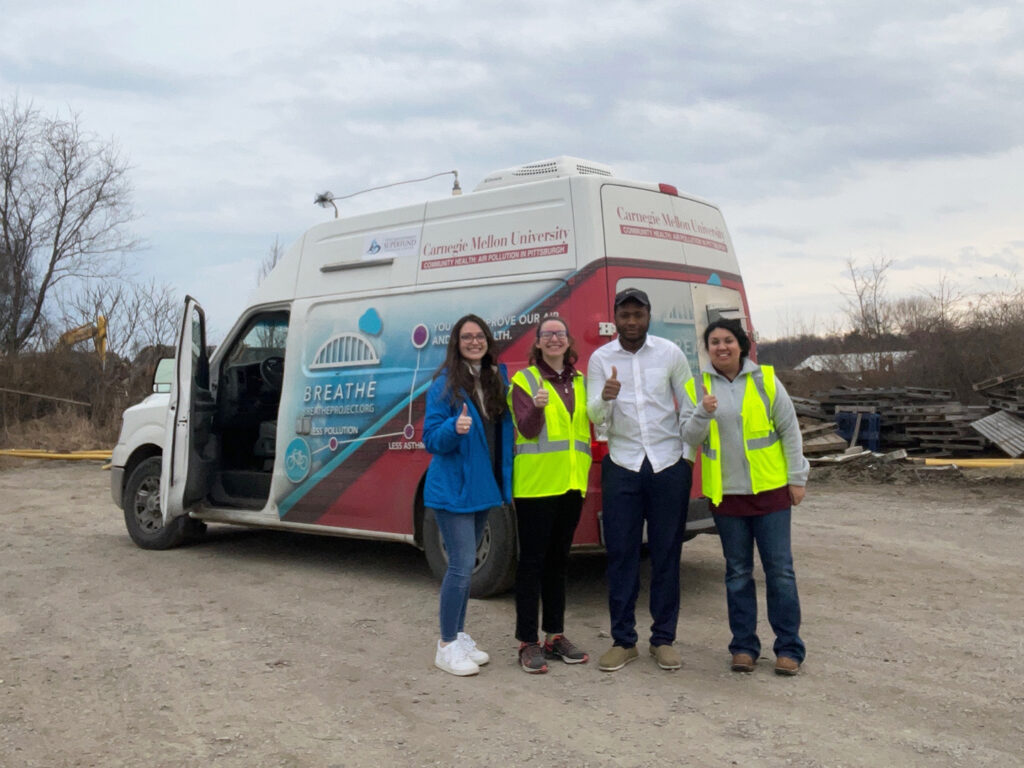Texas A&M, Carnegie Mellon Researchers Test Air Pollution In East Palestine, Confirm EPA’s Findings But Identify Future Needs For Continued Sampling
Story by Megan Myers, VMBS Communications

Additional data was released by the Texas A&M Superfund Center on March 9 and is available on Twitter.
Independent data collection by the Texas A&M Superfund Research Center and Carnegie Mellon University has corroborated the U.S. Environmental Protection Agency’s (EPA) findings on air quality in East Palestine, Ohio.
Researchers from the two universities, both partners in the Texas A&M Superfund Research Center, used Carnegie Mellon’s Center for Atmospheric Particle Studies Mobile Air Quality Lab to test for several pollutants on Feb. 20-21, less than three weeks after a Norfolk Southern freight train carrying hazardous materials derailed near the city.
Their data agreed with the EPA conclusions that concentrations of benzene, toluene, xylene, and vinyl chloride were below minimal risk levels for intermediate duration (15 days to 1 year) exposures, as set by the Agency for Toxic Substances and Disease Registry. Neither the EPA nor the independent researchers detected any hot spots for these chemicals, or areas where emissions from specific sources can expose local populations to elevated health risks.
They also confirmed levels of acrolein that varied greatly, both spatially and over time, and occasionally rose above safety thresholds for long-term health concerns.
Acrolein is a colorless liquid chemical that becomes vapor when heated and can cause lung damage when inhaled over a long period of time.
According to the corroborating data from the Texas A&M Superfund Center and Center for Atmospheric Particle Studies at Carnegie Mellon, acrolein levels in East Palestine ranged from five times lower to three times higher than levels in downtown Pittsburgh, which has levels consistent with most major U.S. cities. These levels are of note because East Palestine is in a rural area and would be expected to have lower concentrations.
“Going forward, there needs to be continued monitoring, not just for acrolein but also to figure out if there are other chemicals in the air that will be a concern,” said Dr. Weihsueh Chiu, a professor at the Texas A&M School of Veterinary Medicine & Biomedical Sciences and deputy director of the Superfund Center. “But I wouldn’t say that any of our data suggests an immediate safety hazard.”
As of right now, many of the long-term implications of the disaster are still unknown.
“The federal and state authorities are recognizing that they need to broaden the scope of their air quality measurements and to bring additional sensitive equipment,” said Dr. Ivan Rusyn, a University Professor of toxicology in the VMBS and director of the Superfund Center. “The EPA has given notice that this week, they’re deploying a mobile sampling laboratory that can do testing throughout town and the area, as opposed to the fixed monitors that they have been deploying and the handheld monitors that are not very sensitive. So, the overall response is trending in the right way.”
Providing an objective corroboration of the EPA’s data is especially important in East Palestine, where many residents are struggling to trust the government’s conclusions.
“Our colleagues at both the state and federal EPA have tremendous expertise in this area, but they could have done a little better of a job communicating exactly what ‘safe’ means in terms of duration of exposure and types of chemicals and mixture,” Rusyn said. “One additional reason to continue testing is for communication purposes, to really reassure the residents and explain to them where the levels after the disaster are as compared to a baseline.”
How involved the Superfund and Carnegie Mellon researchers will be in additional testing will depend on their ability to conduct testing without interfering with the EPA’s work.
“If we can help with additional sampling, we will,” Rusyn continued. “What we’ve done in the past, both at Carnegie Mellon and here at Texas A&M, is provide additional measurements over time, weeks and month after, to understand whether the levels after the disaster were abnormal or were just within the range. Unless you have data after the disaster, you really do not know whether you’re measuring spikes or you’re measuring background.”
In addition to Rusyn and Chiu, the other researchers involved in the data collection and review were Dr. Natalie Johnson, an associate professor at the Texas A&M School of Public Health, and Dr. Albert Presto, a research professor at Carnegie Mellon University. Graduate students Ruby Hernandez and Mariana Saitas and undergraduate research assistant Lyssa Losa participated in the air sampling campaign in East Palestine on Feb. 20-21.
Institutional support to the Superfund Center from the Texas A&M Division of Research was used to support sampling and data analysis.
###
For more information about the Texas A&M College of Veterinary Medicine & Biomedical Sciences, please visit our website at vetmed.tamu.edu or join us on Facebook, Instagram, and Twitter.
Contact Information: Jennifer Gauntt, Director of VMBS Communications, Texas A&M College of Veterinary Medicine & Biomedical Sciences, jgauntt@cvm.tamu.edu, 979-862-4216


